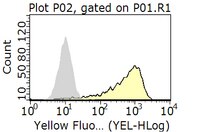Tim4- and MerTK-mediated engulfment of apoptotic cells by mouse resident peritoneal macrophages.
Nishi, C; Toda, S; Segawa, K; Nagata, S
Molecular and cellular biology
34
1512-20
2014
Mostra il sommario
Apoptotic cells are swiftly engulfed by macrophages to prevent the release of noxious materials from dying cells. Apoptotic cells expose phosphatidylserine (PtdSer) on their surface, and macrophages engulf them by recognizing PtdSer using specific receptors and opsonins. Here, we found that mouse resident peritoneal macrophages expressing Tim4 and MerTK are highly efficient at engulfing apoptotic cells. Neutralizing antibodies against either Tim4 or MerTK inhibited the macrophage engulfment of apoptotic cells. Tim4-null macrophages exhibited reduced binding and engulfment of apoptotic cells, whereas MerTK-null macrophages retained the ability to bind apoptotic cells but failed to engulf them. The incubation of wild-type peritoneal macrophages with apoptotic cells induced the rapid tyrosine phosphorylation of MerTK, which was not observed with Tim4-null macrophages. When mouse Ba/F3 cells were transformed with Tim4, apoptotic cells bound to the transformants but were not engulfed. Transformation of Ba/F3 cells with MerTK had no effect on the binding or engulfment of apoptotic cells; however, Tim4/MerTK transformants exhibited strong engulfment activity. Taken together, these results indicate that the engulfment of apoptotic cells by resident peritoneal macrophages proceeds in two steps: binding to Tim4, a PtdSer receptor, followed by MerTK-mediated cell engulfment. | 24515440
 |
Synergistic effect of Tim4 and MFG-E8 null mutations on the development of autoimmunity.
Miyanishi, M; Segawa, K; Nagata, S
International immunology
24
551-9
2011
Mostra il sommario
Phagocytes, including macrophages, recognize phosphatidylserine exposed on apoptotic cells as an "eat me" signal. Milk Fat Globule EGF Factor VIII (MFG-E8) is secreted by one subset of macrophages, whereas Tim4, a type I membrane protein, is expressed by another. These proteins bind tightly to phosphatidylserine on apoptotic cells and enhance their engulfment by macrophages. To study the contribution of these proteins to the engulfment of apoptotic cells, we established a mouse line that was deficient in the genes encoding MFG-E8 and Tim4. The null mutation of Tim4 impaired the ability of resident peritoneal macrophages, but not thioglycollate-elicited macrophages, to engulf apoptotic cells. Mice deficient in either MFG-E8 or Tim4 on the C57BL/6 background developed hardly any autoantibodies, but aged female mice deficient in both MFG-E8 and Tim4 developed autoantibodies in an age-dependent manner. Tumour necrosis factor (TNF) α is known to protect against systemic lupus erythematosus-type autoimmunity, whereas type I IFN accelerates the disease. Indeed, the administration of an anti-TNFα antibody or a reagent that stimulates the IFN-α production [2,6,10,14-tetramethylpentadecane (TMPD; also known as pristane)] enhanced the production of autoantibodies in the MFG-E8- and Tim4-double-deficient mice. These results suggest that the double deficiency of Tim4 and MFG-E8, phosphatidylserine-binding proteins, can trigger autoimmunity and that TNFα and type I IFN regulate reciprocally the development of autoimmune disease. | 22723547
 |
Identification of Tim4 as a phosphatidylserine receptor.
Miyanishi, M; Tada, K; Koike, M; Uchiyama, Y; Kitamura, T; Nagata, S
Nature
450
435-9
2007
Mostra il sommario
In programmed cell death, a large number of cells undergo apoptosis, and are engulfed by macrophages to avoid the release of noxious materials from the dying cells. In definitive erythropoiesis, nuclei are expelled from erythroid precursor cells and are engulfed by macrophages. Phosphatidylserine is exposed on the surface of apoptotic cells and on the nuclei expelled from erythroid precursor cells; it works as an 'eat me' signal for phagocytes. Phosphatidylserine is also expressed on the surface of exosomes involved in intercellular signalling. Here we established a library of hamster monoclonal antibodies against mouse peritoneal macrophages, and found an antibody that strongly inhibited the phosphatidylserine-dependent engulfment of apoptotic cells. The antigen recognized by the antibody was identified by expression cloning as a type I transmembrane protein called Tim4 (T-cell immunoglobulin- and mucin-domain-containing molecule; also known as Timd4). Tim4 was expressed in Mac1+ cells in various mouse tissues, including spleen, lymph nodes and fetal liver. Tim4 bound apoptotic cells by recognizing phosphatidylserine via its immunoglobulin domain. The expression of Tim4 in fibroblasts enhanced their ability to engulf apoptotic cells. When the anti-Tim4 monoclonal antibody was administered into mice, the engulfment of apoptotic cells by thymic macrophages was significantly blocked, and the mice developed autoantibodies. Among the other Tim family members, Tim1, but neither Tim2 nor Tim3, specifically bound phosphatidylserine. Tim1- or Tim4-expressing Ba/F3 B cells were bound by exosomes via phosphatidylserine, and exosomes stimulated the interaction between Tim1 and Tim4. These results indicate that Tim4 and Tim1 are phosphatidylserine receptors for the engulfment of apoptotic cells, and may also be involved in intercellular signalling in which exosomes are involved. | 17960135
 |










